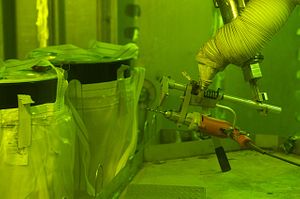There have been two breakthroughs in the cleanup process of the Fukushima Daiichi Nuclear Power Plant in the past week. The prefectural government in Fukushima has reached an agreement with the local population for the storage of radioactive waste, which will facilitate the cleanup process at the facility. Meanwhile, the national government is looking to increase funds for the dismantling of the affected reactors. These two policies in tandem are likely to be much more effective in managing the nuclear crisis than the government’s most recent attempts to build an “ice wall” to prevent groundwater from entering the facility and becoming contaminated, as the cleanup process seeks to reach and then effectively contain the damaged fuel rods.
The national government’s attempts to reach an agreement with the local governments of Okuma and Futaba in Fukushima on an interim storage facility were stalled indefinitely after Environment Minister Nobuteru Ishihara offended the local population in June, saying that “In the end, it will come down to money.” To resolve the situation, the prefectural government stepped in to fill the gap in the value of the land to be used as the storage site. It will pay the difference between the current value of the land in Futaba and Okuma and the price it was worth before the nuclear accident in 2011. Interestingly, the prefecture expects the local communities to accept their offer, but will wait to formally sign the agreement on September 2, as it wants to announce the deal the day before Prime Minister Shinzo Abe’s new Cabinet is announced. Ishihara is expected to be replaced in the upcoming Cabinet.
With an interim storage facility secured for radioactive soil and other waste, the cleanup process at Fukushima Daiichi is expected to advance more smoothly. The Ministry of Education, Culture, Sports, Science and Technology is developing concurrent plans to research how to dismantle the reactors and dispose of highly radioactive waste, such as the melted nuclear fuel rods. It has submitted a 8.1 billion yen ($77.9 million) budget, 2 billion yen of which would be used for a reactor dismantlement research center, while the remainder would be spent to research how to dispose of the melted fuel rods. The Abe government has already given approval for a facility to dismantle the reactors, which ministry officials say will apply the latest research in robotics.
The Japanese government has looked into many different approaches to dealing with the long-term storage of radioactive waste, with these two items representing a potentially positive step in speeding up those efforts. Storing irradiated water, the accident prone technology used to treat it before releasing it into the ocean, and preventing groundwater from entering the damaged reactors still appear to be substantial problems, although Tokyo Electric Power Co. (TEPCO) believes it is making good progress on the “ice wall” and will meet its 2015 deadline to install it. Effective water contamination prevention, waste storage, and the final ability to adequately dispose of damaged fuel rods appear to be the three major components of a long-term solution to the Fukushima Daiichi disaster cleanup.

































